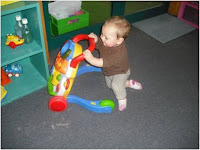This blog is about how 'things' and there significance on children's learning and development
E X P L O R I N G T E C H N O L O G Y
E will be 1 year old at the end of 2010. She has been with us in the infant room from the age of 3 months old. E is definitely one of our more physically active infants and has been from day one. She is always happy when she is on the move and is loving her new found freedom of being able to get to were she wants to go independently and now being able to do this while standing on her two legs "The key skills in learning to walk appear to be stablilizing balance on one leg long enough to swing the other forward and shifting the weight without falling. This is a difficult biomechanical problem to solve, and it takes infants about a year to do it" (Santrock, 2008, p. 154).
 I have noticed E paying attention to a piece of 'technology' that we have in our room "Assistive technology can include adapted toys, computer, seating systems, powered mobility equipment, augmentative communication devices, adaptive technology solutions to improve an individual's ability to learn, compete work, and interact with family and friends" (Pierce, n.d, p. 1).
I have noticed E paying attention to a piece of 'technology' that we have in our room "Assistive technology can include adapted toys, computer, seating systems, powered mobility equipment, augmentative communication devices, adaptive technology solutions to improve an individual's ability to learn, compete work, and interact with family and friends" (Pierce, n.d, p. 1). In this picture E is exploring the 'push walker' pushing it forward while she is on her knees. She has seen it before around the room when other infants have used it but this is the first time she has been interested in touching it and finding out how it work's herself "exploration, and curiosity are important and valued ways of learning" (Ministry of Education, 1996, p. 84).
In this picture E is exploring the 'push walker' pushing it forward while she is on her knees. She has seen it before around the room when other infants have used it but this is the first time she has been interested in touching it and finding out how it work's herself "exploration, and curiosity are important and valued ways of learning" (Ministry of Education, 1996, p. 84). During this activity E is learning how to construct knowledge cognitive development is often associalted with two concepts. "Children are believed to learn through active personal engagement with and explorations of their environment. Through involvement, children build or construct their knowledge as explanations for what they experience" (Talay-Ongan & Ap, 2005, p. 62).
During this activity E is learning how to construct knowledge cognitive development is often associalted with two concepts. "Children are believed to learn through active personal engagement with and explorations of their environment. Through involvement, children build or construct their knowledge as explanations for what they experience" (Talay-Ongan & Ap, 2005, p. 62). E tries to stand with her hands on the handle the push walker went forward and hit into the shelf. This made E alittle nervous and she went back down onto the safety of her knees where she would try to push it along while trying to crawl as well she was alittle nervous but you could tell on her face that she loved being in control of the push walker and being able to use this piece of technology to get around the room. I could see E trying to stand up again so I went over to her and demonstrated how to use it and then assisted E in positioning her on the push walker and guiding her along "guidance and support to children moving from one level of competence to another" (McNaughton & Williams, 2004, p. 331).
E tries to stand with her hands on the handle the push walker went forward and hit into the shelf. This made E alittle nervous and she went back down onto the safety of her knees where she would try to push it along while trying to crawl as well she was alittle nervous but you could tell on her face that she loved being in control of the push walker and being able to use this piece of technology to get around the room. I could see E trying to stand up again so I went over to her and demonstrated how to use it and then assisted E in positioning her on the push walker and guiding her along "guidance and support to children moving from one level of competence to another" (McNaughton & Williams, 2004, p. 331). R E F E R E N C E S
Ministry of Education. (1996). Te whariki he whariki matauranga mo nga mokopuna o aotearoa: Early childhood curriculum. Wellington, New Zealand. Learning Media.
McNaughton,. G. Williams. G (2004). Techniques for teaching young children choices in theory and practice. Malaysia: Pearson Prentice-Hall.
Pierce,. P. (n.d). Assitive technology and infants and toddlers. Retrieved 11th September, 2010, From ww2. edc.org/ncip/library/ec/power_1htm
Santrock,. J.W. (2008). Life span development. (11th ed. International). Boston. McGraw-Hill.
Talay -Ongan,. A. Ap,. A.E (Ed.s). (2005). Child development and teaching young children. Victoria, Australia: Thompson Social Science Press.



